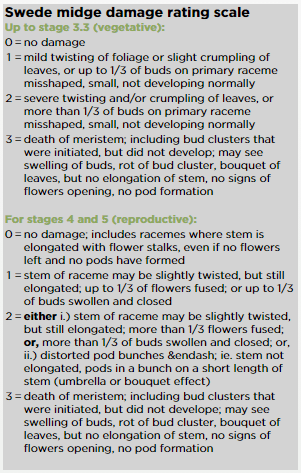Key Result
This study revealed new information about yield losses from aster yellows, tentative economic thresholds for leafhoppers, and the lifecycle patterns and host preference of swede midge. Growers should scout crops for swede midge and leafhoppers and consult with agronomists if either pest or aster yellows are identified.
Project Summary
New threats: Aster yellows and swede midge
The objectives of this project were to determine the extent of infestation, evaluate yield losses, develop forecast warnings and identify resistant canola lines for two Prairie pests – aster yellows and swede midge.
Aster yellows is an insect-vectored disease that affects many crops, including significant canola yield loss observed in 2012 with incidence as high as 80 per cent in some fields.
Swede midge Contarinia nasturtii (Keiffer), native to Europe, is an insect pest of crucifer crops. While some damage has been seen in canola in Ontario since 2000, it was only in 2012 that damage was found in commercial spring canola on the Prairies.
Swede Midge
Plots were established at Agriculture and Agri-Food Canada in Melfort, Sask., in 2014 and 2015 to study swede midge in the field. In both years, the first midges to appear in the pheromone traps and in the emergence cages were in early July when most plants were starting to flower. Data indicated the presence of two generations of swede midge occurring in the canola plots annually; the first with larvae in the crop and the second, in August, with larvae feeding on volunteer canola and other weeds.

Results showed no differences among lines of glyphosate-tolerant Brassica napus in terms of insect injury. In comparing six different species of Cruciferae, plants of Camelina sativa (camelina) and Sinapis alba (white mustard) were less injured than the others by swede midge and C. sativa appeared to be resistant. These more-resistant crucifers may provide a source of resistance.
Swede midge survey results found that populations are increasing and have spread westward across Saskatchewan.
Aster Yellows
Aster yellows is a phytoplasma organism that causes misshapen pods and flower buds and is mainly transmitted by the six-spotted leafhopper (Macrosteles quadrilineatus) in canola. The six-spotted leafhopper is a migratory insect whose populations tend to be higher in years when suitable wind currents arrive early in the growing season from southern USA. Field surveys conducted across Saskatchewan from 2013–2015 found very low aster yellows incidence: 1.4 per cent of samples analyzed in 2013, nil in 2014 and less than one per cent in 2015.
The research also compared B. napus germplasm to look for tolerant/resistant lines in plots at Saskatoon. In 2012, visual observations identified several lines that did not show aster yellows symptoms. However, many of the observations on tolerant/resistant germplasms observed in the 2012 canola nursery could not be confirmed in subsequent years. Similarly, no difference in aster yellows incidence was found between commercially available cultivars, mostly because of the low aster yellows incidence that did not allow comparison.
Three assays were developed to provide highly efficient, selective and fast identification of aster yellows.* Field testing is also underway for a new rapid molecular technique (LAMP) to determine the infectivity of leafhoppers and the aster yellows incidence in the field. A rating scale for aster yellows symptoms was developed.





